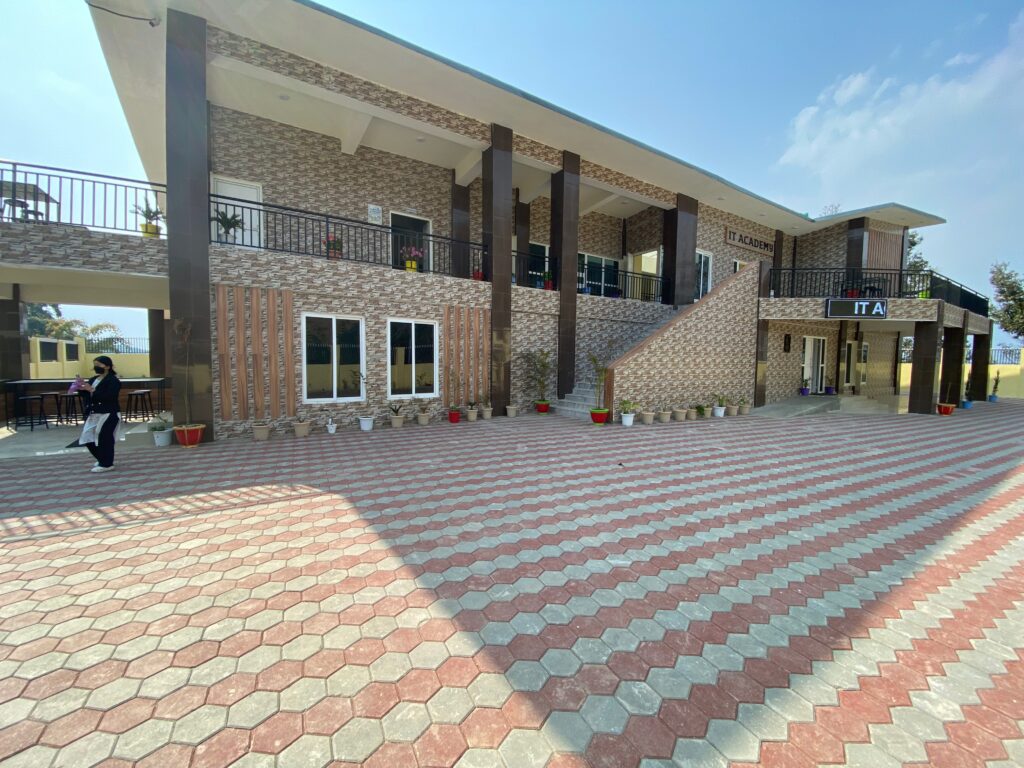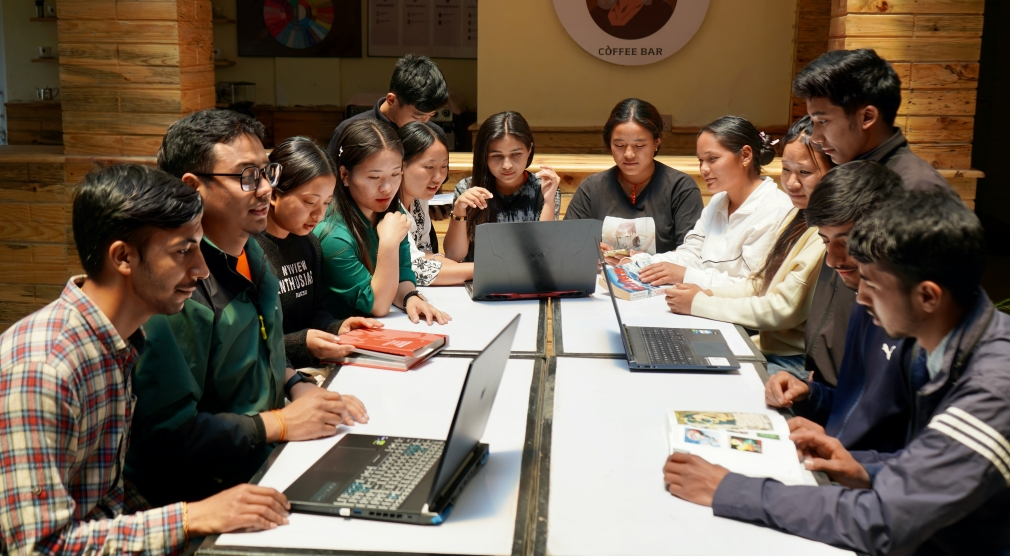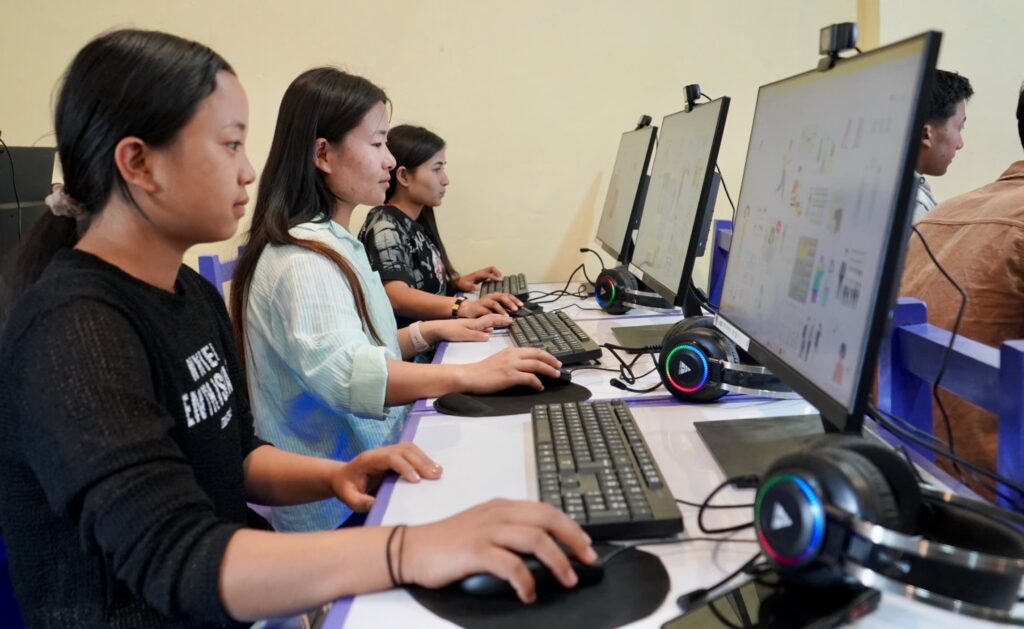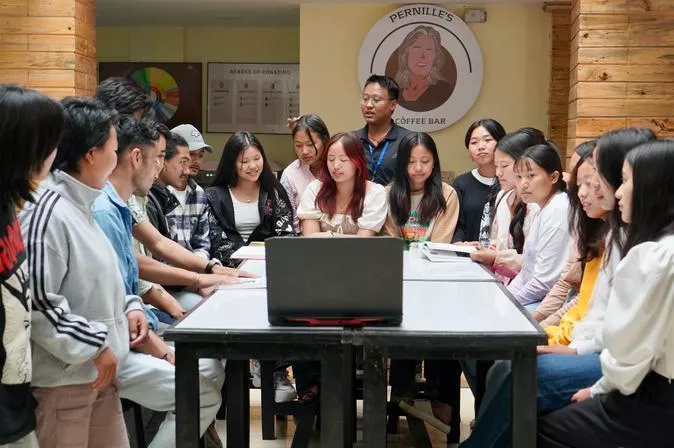An IT academy in eastern Nepal trains students to earn as internet freelancers, reducing outmigration
Marty Logan in Taplejung
Kathumandu (Nepali Times) – After graduation Danber Maden was working as an accountant and in his spare time practising his passion for sketching. Wanting to adapt his talent to digital design, he joined a new course at Bhanu Jana Secondary School here.
Today, Maden is a mentor for new students at what has become the IT Academy, Taplejung. The 24-year-old is now juggling various online design gigs with companies worldwide, and earning much more than he did as an accountant.
“I’m learning 3D design and motion graphics, animation from YouTube,” says Maden, sitting in the spacious Academy on the grounds of the secondary school.
Light-coloured walls, extra high ceilings and a wide wooden staircase give the building a bright touch. Nearby is a group working area fronting the wood-panelled Pernille’s Coffee Bar. It is named after Pernille Madsen, founder of Human Practice Foundation (HPF), a Danish NGO that has been supporting schools and their communities in Taplejung since 2017.

Launched in 2014, HPF also runs programmes in Denmark and Kenya.
Donor Waldemar Schmidt says he and his Academy co-founders wanted to give students at HPF-supported schools in the district another option after graduating.
“Some years ago I started thinking, ‘what happens to the children when they leave the school? Have we done the job of giving the children a better future’? The simple answer was ‘no, I don’t think we have—we need to do more’,” he says in a Zoom interview from Denmark.
The Academy opened in November 2023. To date, 61 students have graduated and 14 are working online, says Bhanu Jana’s head teacher Kishor Kumar Rai. Some are working for companies in Singapore, Denmark and South Korea.
“They are earning more money here than doing other work so they are happy to stay in Taplejung,” adds Rai. “The Academy will stop migration and also the brain drain of youth.”
A new, six-month session on graphic design and digital marketing started in June. Besides the technical component, students also learn the skills needed to become successful online freelancers, such as writing offers and negotiating contracts.

By 2028, HPF aims to have graduated up to 800 digital workers in courses that include web development and cyber-security in Levels 2 and 3. Graduates of Level 1 will need to pay tuition for advanced courses and prove that they are already earning as freelancers, explains Schmidt.
“We don’t want to be known as a place that does a bit of everything. We want to build a brand which is very strong in graphic design and cyber security,” he adds.
A former CEO, Schmidt knew HPF founder Madsen from the corporate world. Today he is the driving force behind the IT Academy, as quick to recite the latest facts and figures as he is to share a vision for the next decade.
Schmidt estimates that after graduating from Level 1 students will have the potential to earn $500 a month, compared to the $200 locals make working in banks and other offices. After taking Level 2 and 3 courses in graphic design and cyber security, earnings will rise to $1,000-2,000 monthly, he predicts.
HPF now subsidises tuition, leaving students to pay 15%, or about Rs 5,000, of the cost of the courses. Schmidt says donors in his personal network have covered the remaining amount (about $500 per student) for the first 100 students this year. For the next session he hopes sponsors will chip in $1,500 per student, enough to also buy each one a laptop.
An enthusiastic, well-connected former CEO, the 84-year-old Schmidt has also called on his network to take on graduates in their firms as interns, and convinced WorldLink to provide the Academy with fibre-optic Internet at no cost.
Developing students’ skills so that they are competitive globally will also happen gradually, says Schmidt, in part because of English-language skills. In the beginning, the Academy will focus on work experience in Asia. Already it has arranged virtual internships in companies in Singapore, Vietnam and Indonesia.
The Academy’s 10-point manifesto is also training women students who can continue working as freelancers while raising families. Women make up 60% of students, and head of the Academy Basanta Palungwa says female students design more creatively, in part because they are more patient.

The Academy also aims to digitise and engage the community in this remote corner of north-eastern Nepal. Plans include a course for the general public on using smartphones and tablets, and WorldLink will soon install wifi hotspots. Also in the planning stage is vocational training for those who are not inclined to IT.
HPF-supported secondary schools in Taplejung are graduating about 1,000 students a year, but the IT Academy will be able to accommodate less than half of them.
Says Schmidt: “They may be frustrated because they’ve been to a good school and they see no future after graduating, so we need to make sure that there’s a link to the labour market.”
After graduating, Danber Maden’s freelance work now includes four hours daily for Bookmundi, a Denmark based travel agency. After interning there for one year he was recently promoted to Junior Graphic Designer.
For the past year he has also been designing social media posts for GenX Pharmacy, an online business based in Kathmandu. And he has local clients, including candidates who ran in the last elections.
The local boy seems to have found his niche online. Asked what he sees himself doing in 10 years, Maden responds confidently: “Senior designer or art director.”
INPS Japan/Nepali Times
Origina Article: https://nepalitimes.com/here-now/going-global-to-retain-local-talent




